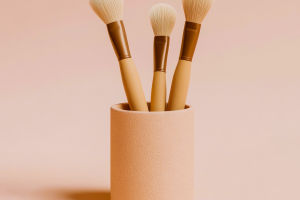The technique of using liquid foundation and makeup brushes is particularly important in the makeup process.
Mastering the correct use of these two tools can not only ensure a more even and natural makeup but also greatly improve the overall look and longevity of the makeup.
However, many people overlook crucial details in this process, resulting in a makeup look that is less refined or long-lasting. The combination of liquid foundation and makeup brushes is not simply about applying the product to the face. It is a gradual and skillful process, aimed at creating a flawless and long-lasting finish.
First, choosing the right liquid foundation is especially important. There are various types of liquid foundations available on the market, and the most common ones include matte, dewy, lightweight, and high-coverage types.
You should choose the right foundation based on your skin type, skin tone, and makeup needs for the day. For example, oily skin is usually best suited to matte or oil-control foundations, while dry skin benefits more from moisturizing and dewy products. The right foundation can make the skin look more natural without the makeup appearing too heavy or cakey.
Secondly, the choice of makeup brushes is also a key factor. Liquid foundation can be applied using different types of brushes, including flat foundation brushes, rounded foundation brushes, and multi-purpose beauty sponges. Each type of brush creates a different effect.
For example, a flat foundation brush is ideal for creating an even base, as it spreads the foundation smoothly and helps it adhere well to the skin.
On the other hand, a rounded foundation brush is more suitable for precise application, especially around the eyes and the sides of the nose. If you prefer a lighter and more breathable look, a beauty sponge is a great choice because it blends the foundation seamlessly, leaving a natural finish.
Before using a liquid foundation, it is essential to ensure that your skin is clean and well-hydrated. A flawless base makeup starts with good skincare habits.
Before applying any makeup, using a moisturizer or primer can help the foundation blend better into the skin and prevent it from caking or settling into fine lines. Moisturizing is especially important for dry skin, as it provides the hydration needed for a smooth application.
Next comes the actual makeup application. Squeeze out an appropriate amount of liquid foundation—typically, one pump is enough to cover the entire face. Apply the foundation evenly on the forehead, cheeks, nose, and chin, and then use a makeup brush to spread it out.
The key is to use a patting technique rather than dragging the skin, which can lead to streaks and unevenness. Patting not only helps to avoid uneven marks but also prevents the foundation from losing its radiance due to excessive friction. Around the eyes and nose, where the skin is more delicate, careful blending is necessary to avoid product buildup.
When using a makeup brush, it’s also important to pay attention to the amount of pressure applied. Gently pressing and patting the skin helps the foundation adhere better, creating a more natural glow.
On the other hand, using too much force can result in the foundation being applied too thinly or leaving brush marks, which can negatively impact the overall finish.
For a more refined look, use the brush to blend the foundation in gentle circular motions. This technique not only ensures an even application but also enhances the longevity of the base makeup.
For liquid foundations with higher coverage, you can opt to apply the foundation in layers. Start with a thin layer, allowing it to blend into the skin before adding more where needed.
For example, the T-zone, cheeks, and areas with imperfections can be built up to improve coverage. This method ensures that the makeup remains light while effectively concealing blemishes, resulting in a natural, flawless finish.
Setting the makeup is the final step after applying a liquid foundation and using a brush. Although liquid foundation can provide some coverage and a radiant finish, setting products are essential for making the makeup more durable.
You can use either a setting spray or powder, gently pressing it onto the face—particularly in areas prone to oiliness, such as the T-zone and chin. This step helps lock in the foundation, prevent excess oil, and avoid makeup breakdown, thereby increasing the longevity of the look.
Mastering the combination of liquid foundation and makeup brushes requires both skill and patience. From selecting the right liquid foundation to choosing the appropriate brush and applying the product with the proper technique, each step plays a crucial role in determining the final result.


